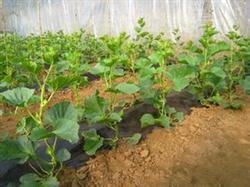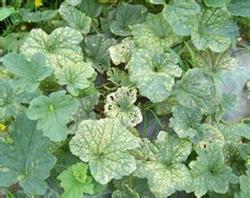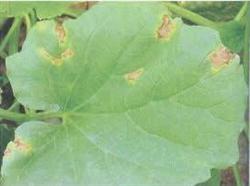Control of main diseases and insect pests of melon

With the adjustment of planting structure and the rapid development of high-efficiency agriculture, the area of watermelons and melons in planting sheds, middle greenhouses, greenhouses and greenhouses has increased year by year. Due to successive cropping, disease and insect sources have accumulated year by year, resulting in an increase in the number of diseases and insect pests year by year. In order to control the damage of diseases and insect pests and ensure the high yield, high quality and high efficiency of watermelon planting, we must adhere to the principle of "agricultural measures are given priority to and chemical control is secondary". The main pest control techniques are introduced as follows: first, epidemic disease: the disease is the main disease from seedling stage to rosette stage of watermelon and muskmelon. The leaves infected with the primary dark green water immersed irregular disease spot, then expanded in the form of soft rot, the disease spot became brown and easy to break when dry; the stem base infected, the primary fusiform dark green water immersed disease spot, and then around the stem base constricted rot, and finally withered. Prevention and treatment methods: seed disinfection before sowing, soaking seeds in 55 ℃ warm water for 15 minutes; nutrient soil sterilization, adding 50% carbendazim per cubic meter of nutritious soil and mixing well; in the initial stage of the disease, spray 500 times with 64% poison alum, 72.2% Prik 800 times or 58% Redomil (Ruidu Manganese Zinc) 500 times, and spray again every 7-10 days. Second, vine blight: the disease mainly occurs in the leaves and stems, the leaves infected with the initial nearly round spot or V-shaped light brown spot from the leaf edge to the inside, the spot is broken in the later stage, and many small black spots are born in the conidium. Stem vine infection at the beginning of the oval to fusiform disease spot, dry shrinkage in the later stage, and overflow of yellow colloid, serious leaf withering, stem vine rot. Prevention and treatment?: avoid watering on cloudy days and strive for continuous sunshine after watering. In case of continuous overcast and rain after watering, pay attention to short-term dehumidification at noon; at the initial stage of the disease, use 75% chlorothalonil 600 times, or 70% methyl topiramate 800 times + 80% Dasheng (or Yuesheng) 800 times spray; remove the residual body in time after harvest to reduce the source of bacteria. Third, anthrax: anthrax can occur throughout the growth period, and the infected leaves are round to spindle-shaped or irregular water-immersed spots, sometimes with wheel lines, easy to break and perforate when dry, and pink sticky matter on the leaf surface when wet; petiole or stem vines infected with primary water immersion round spots turn black after slightly sunken, and die around the stem vines in severe cases The fruit is infected, the primary water immersion brown spot, the depression is often cracked, when the humidity is high, there is a pink sticky substance in the middle of the spot, and in serious cases, the spot is rotten. Control methods: select disease-resistant seeds; seed scalding disinfection; initial use of 70% methyl thiophanate 800 times, 75% chlorothalonil 600 times, or 80% anthrax Fumei 800 times spray, spray again every 7-10 days. 4. Bacterial angular spot: the disease is a disease in the middle and later stages of melons, which mainly occurs in leaves. The general diseased plant rate in watermelon fields in greenhouse is about 25%, the highest is 70%, and the diseased leaf rate is about 10%. After the leaf infected, the primary needle tip size transparent spots, enlarged to form a yellowish spot with yellow halo, the center became brown or gray-white perforation rupture, when the humidity was high, the disease produced milky white bacteria overflowing pus. Prevention and treatment methods: select disease-free seeds; warm scald and disinfect seeds; at the initial stage of the disease, use 13% ammonia copper water, 50%DT (copper succinate) wettable powder 500x, 77% can kill powder 400x, or 72% agricultural streptomycin wettable powder 400x spray, spray again every 7-10 days. Fifth, powdery mildew: the disease mainly harms the leaves. At the beginning of the disease, there are white near round star-shaped small powder spots on the front of the leaves, then expand around to form continuous pieces of white powder with inconspicuous edges, and in severe cases, they cover the whole leaves, turn gray-black in the later stage, and the diseased leaves turn yellow and withered. Prevention and control methods? Implement large and small ditch wheel irrigation, timely ventilation in sunny days, pay attention to dehumidification in cloudy days, timely tapping and removal of old leaves to avoid field depression; at the initial stage of the disease, 40% DuPont "Fuxing" EC 4 grams (1 bag), or 0116 biological pesticides 150 times water spray. 6. Virus disease: there are mainly two types: mosaic type and wrinkled type, which specifically shows that the top leaves of the plant produce deep and shallow mosaic disease spots, the leaves become smaller, curly, wrinkled and deformed, and can not bear melons in the early stage and small and deformed in the later stage. Prevention and control methods? Do everything possible to lower the temperature and appropriately increase the humidity in the shed; early removal of diseased plants to reduce the source of virus; control aphids and disease prevention, from the seedling stage, use 10% imidacloprid 1500 times, or 5% cypermethrin 2000 times spray; at the initial stage of the disease, use 30% virus A 500 times or 1.5% phytopropathogen 1000 times spray. 7. Root-knot nematode disease: there are small bumps in the main root and lateral root in the early stage of the disease, and when it is serious, the root is swollen, affecting the absorption of water and nutrients. Control methods: choose disease-free fertilizer soil to raise seedlings; discarded diseased seedlings, can not be planted; soil treatment before planting, kill 5 kg per mu with 3% nematodes, spread evenly in the planting ditch and then plant seedlings. (4) high temperature in summer for more than 30 days, and thoroughly remove the diseased body after pulling seedlings. 8. Melon aphid: adult aphids and nymphs like to suck juice on the growth point, tender leaves, back of leaves and tender stems of melon seedlings, resulting in short leaf curl, no pollination or even leaf shedding when the damage to the adult plant is serious, and the secretion of honeydew affects light and respiration at the same time, and it is also the main vector for the transmission of virus disease. Control methods: yellow board to trap aphids or silver-gray reflective plastic film to drive aphids; spray 10% imidacloprid 1500 times, 5% acetamiprid 800x, or 5% cypermethrin 2000 times; spray roof with 1000 times 80% dichlorvos, or fumigate 80% dichlorvos 300,400ml mixed with water and fine sand per mu. 9. Red spider: nymphs and adults suck juice on the back of the leaves, which makes the leaves lose green, turn yellow and white, affect the formation of light and products, and in serious cases, the leaves dry up, can not pollinate, or even the whole plant dies. Control methods: winter ploughing is carried out after autumn crop harvest; after summer crop harvest, weeds and fallen leaves of stems and vines are thoroughly removed to eliminate the source of insects in the last crop. Before planting watermelons in autumn, the whole field should be covered with water to increase air humidity; at the initial stage of occurrence, 3000 times of 20% paraben or 1.8% avermectin should be sprayed. Melon thrips: suck the sap of tender leaves, tender tips, flowers and young fruits of melons with adult and nymph files, the tender tips of the injured tender leaves become hard and small, the plant growth is slow, the internodes are shortened, the young melons are harden black, the melon expands slowly, the peel is rough, and even causes falling melons, the key is to seriously affect the yield and quality. Prevention and control methods: at the initial stage of occurrence and the initial stage of setting melon, pyrethrin pesticides were sprayed 2000 times. 11. Tea mites: adult mites and young mites are concentrated in the young part of the crop, the back of the damaged leaves are gray-brown or yellowish brown, with grease luster or oil-stained shape, the edges of the leaves are curled downward, the tender stems and twigs are twisted and deformed, and the leaves become narrower, stiff and erect, finally bald, and the top of the serious plant dries up. Control methods: remove weeds and litter in the field; pay attention to regular ventilation and reduce the temperature in the shed; spray 73% propargite 2000 times, 20% paraben or 1.8% avermectin 3000 times.
- Prev

Disease control of pollution-free muskmelon
The main pests harmful to muskmelon are maggots, mole crickets, small tigers, grubs, leaf miners, yellow melons, aphids and red spiders. (1) ground maggot: also called root maggot or melon maggot. It's the larva of a fly. The body is about 5 mm long and shaped like maggots, harming the young roots, buds and stems of melon seedlings. The common prevention and control methods are as follows:.
- Next

An ingenious way to prepare muskmelon nutritious soil
Muskmelon leaf blight, also known as brown spot, generally occurs in the peak period of melon, is a fungal disease, can make melon yield sharply reduced, melon less melon small, sweetness greatly reduced. When the external environment is suitable, it is easy to burst out in a short time. The pathogen is mainly harmful to leaves, but also often involves petioles, stems and fruits. Leaf blight starts from the base.
Related
- Moge, come on! The staff of the peasant association in the producing area of cantaloupe were frightened when the crowd gathered.
- Causes and Solutions of low Fruit setting rate of Apple
- Symptoms and control measures of passion fruit virus disease
- Fruit growing lesson: how do apple orchards keep high yields?
- Can you build orchards in the mountains? What are the pros and cons?
- How to manage the coloring period of Crisson grape?
- This paper introduces the processing technology of two kinds of fig products.
- How much is a month for retired teachers in rural areas by 2020?
- How can strawberry planting increase sugar content? We should pay attention to management in many aspects.
- What are the cultivation techniques on how to improve the yield of golden fruit?

